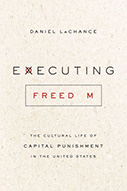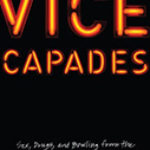Executing Freedom: The Cultural Life Of Capital Punishment In The United States

Author: Daniel LaChance
Publisher: Chicago: University of Chicago Press, 2016. 260p.
Reviewer: Wanda D. Foglia | March 2018
A lot has been written about the death penalty, and Executing Freedom describes much of it and adds an intriguing perspective. This book is a thought provoking exploration of the sources of public support for the death penalty, presenting an impressive array of evidence from historical events, popular culture, social science, political movements and legal scholarship to delve into the subtle, and not so subtle, complexities of capital punishment. As historian Daniel LaChance examines the rise in popularity of the death penalty since the 1970s, he describes the paradoxes and unintended consequences involved with the evolution of cultural attitudes towards the ultimate sanction.
The book jacket and Introduction promise that the book will provide insight into the seemingly contradictory increase in support for allowing the government to execute people as trust in the government decreased in the last half of the twentieth century. Key to understanding this incongruity is appreciating the shift in attitudes away from positive freedom, or the freedom to “achieve one’s will,” and towards negative freedom, or the freedom from “unwanted government constraint” (p. 5). The Introduction overviews LaChance’s argument that this rise in the popularity of libertarianism, changing views of individual responsibility, and longing for decisive justice help explain the increase in support for capital punishment. The three Parts and Epilogue that the make up the remainder of the book elaborate on this argument, and suggest that the failure of the death penalty to live up to expectations may lead to its demise.
Part I, entitled “From Rehabilitation to Retribution,” starts by describing how, in 1966, only 42% of the public supported capital punishment, and popular films depicted murderers as unfortunate victims. It was a time when many believed experts knew how to rehabilitate offenders and government social programs could promote positive freedom and improve lives. However, public support for the death penalty jumped to 54% the following year and continued to climb for the next three decades along with the general tough on crime approach. LaChance agrees with others who have argued that this increasing punitiveness was fueled by anti-black racism, but adds that news stories about senseless killings by whites like Charles Manson also contributed to the shift. Many had begun to feel that liberalism and reliance on experts had resulted in a nihilistic culture that had lost its moral direction and led to these killing sprees. White resentment of paternalistic welfare programs seen as benefiting blacks, and of Warren Court legal reforms seen as neutering law enforcement, are among other reasons offered for why many turned against the centralized, technocratic government and longed for the clear moral message the death penalty could represent. LaChance maintains that these attitudes were reflected in, and reinforced by, movies like Dirty Harry and Death Wish which “celebrated rogue, antitechnocratic, antilegalstic white men who meted out death vigilante-style to menacing threats to the social order” (p. 48).
The second chapter in Part I describes how civil libertarians, uncomfortable with government’s social engineering efforts and distrustful of the government‘s exercise of discretion, joined the push for emphasizing freedom from government interference with the individual’s autonomy. News stories about abusive behavior modification techniques carried out in the name of treatment and fictionalized portrayals of abuse in movies like One Flew over the Cuckoo’s Nest and Clockwork Orange are presented as fueling this feeling that the individual’s autonomy was not being respected by the government. LaChance describes commentators who asserted government attempts to change a person’s thinking were worse than physical death, and maintains that, although it was not their intent, the civil libertarians’ emphasis on protecting the mental autonomy of offenders worked well with the idea of their blameworthiness and helped justify retributive punishment, including the death penalty.
“Executable Subjects” is the title of Part II, which again consists of two chapters. It starts by describing Gary Gilmore’s unapologetic bravado during his 1977 execution, which seems to fit well with the image of an offender exercising his independent free will and being treated as responsible for his actions. However, the focus quickly shifts to the impersonal clinical reality of most executions, and the contrast is used to reflect the conflicting demands that a death sentence “be simultaneously a public assessment of a unique individual and a sober-minded application of objective criteria” (p. 81). This tension is reflected in the seemingly contradictory mandates of United States Supreme Court case law governing capital sentencing which demand unlimited consideration of an individual defendant’s mitigating evidence, while requiring statutory guidelines limiting jurors’ sentencing discretion. It also can be seen in efforts to depict offenders as individuals making free will choices by requesting last meals and making last statements, at the same time executions are conducted in a regimented way meant to minimize human drama.
The next chapter focuses on attempts to distance the death penalty from its racist past, and to humanize capital defendants. After a well documented discussion of the evidence of racism in the application of the death penalty, LaChance describes numerous fictional films that use techniques such as depicting white defendants and black prosecutors, prison guards and wardens. This “whitewashing” of the death penalty, along with the restraint reflected in elaborate legal standards, rights to appeal, and dispassionate execution methods like lethal injection, helped distinguish the capital process from lynchings, or the holocaust. As the use of the death penalty increased during the 1980s and 1990s, films emphasized the defendant’s humanity and suggested spiritual redemption by the end, which fit well with the idea of personal responsibility and retribution. LaChance does not believe this was the filmmakers’ intent, but argues that these portrayals of the death penalty in popular culture helped to legitimate it.
Chapter 5, the first in Part III, “The Killing State,” is devoted to describing two District Attorneys from Harris County, Texas and Oklahoma County, Oklahoma, who enthusiastically utilized the death penalty in the last two decades of the twentieth century. LaChance argues that they, and the death penalty they represented, were popular “because they embodied the possibility that feudal virtues-masculine honor, radical independence, patriarchal clannishness, raw physical strength-could still flourish in a technologically advanced, civilized world” (p.133). It might seem incongruous to devote so much of this small book to just two, albeit colorful, characters in one area of the country, but these two counties were responsible for 12% of the executions between 1977 and 2010 (p. 131), and these two men certainly illustrate the point LaChance is trying to make. This chapter concludes with the observation that, although these prosecutors tried to distance themselves from the racist past of the frontiersman, there is evidence that white anxiety about threats to white supremacy during the 1980s and 1990s might have fueled nostalgia for the strong white hero these men seemed to embody.
The second chapter in Part III emphasizes that many supporters think the death penalty is pursued on behalf of the victim’s family, despite the legal reality that the death penalty is sought against offenders for violating society’s democratically adopted laws. LaChance argues that this view was buttressed by the rise of evangelical Christian conservatism in the 1970s in reaction to what they saw as disturbing cultural changes, and he uses this chapter to explain how their emphasis on “family values” was used to justify harsh punishments. The phrase “family values libertarianism” is used to describe an “ideology of the killing state” that resulted from a combination of the “frontier libertarianism” of the prosecutors described in the previous chapter “with the civilizing virtues of the family” (p.156). This emphasis on the family reflected conservatives’ rejection of a liberal social welfare state they felt was betraying and usurping the role of the family, and disrespecting the common people by assuming liberal government elites had more expertise regarding how children should be raised. The Victims’ Rights Movement became a powerful vehicle for promoting family values conservatism as the damage to victims’ families got more attention in legislative committees, in sentencing hearings, and in media coverage. Approximately half of this chapter is devoted to a discussion of the popular cable television show Dexter, which depicted a forensic scientist who follows his adoptive father’s guidance and discipline to moonlight as a vigilante killer. “Zealous yet self-disciplined, violent yet self-restrained, Dexter embodied the killing state many Americans wished they had” (p. 171). LaChance warns that the decisive justice delivered by Dexter and the idea that the death penalty could serve the interests of the family, are undermined by the reality of multiple appeals and reversals and the movement toward lethal injection that make executions look like medical procedures.
The Epilogue, “Disabling Freedom,” starts with evidence of declining support for capital punishment and the reasons for the decline, but then describes the limits of these reasons and argues that its failure to provide the satisfaction that proponents craved is “the most potent source of the death penalty’s recent decline” (p. 184). Although those who wanted to be free of big government supported the death penalty, the reality is that it has become a big government program. As practiced, the death penalty has not delivered on the promises of popular culture’s depictions that gave it meaning.
Ultimately, recognition that capital punishment cannot be made to live up to its retributive promise, not some moral awakening, will produce a majoritarian consensus against the death penalty. It will end not in fire but in ice, when those unmoved by exonerations or botched executions or evidence of race disparities give up on it (p. 185).
LaChance recognizes that many still support the death penalty although it has not been satisfying for years. He suggests abolitionists increase the emphasis on capital punishment’s failings by focusing on the damage the long appeals process does to the family and friends of homicide victims. He also counsels abolitionists “who generate fictional and perhaps even nonfictional images of the condemned…(t)o create subversive, disillusioning death penalty narratives” that “resist the romance of closure and depict the consequences of an execution not as a soul redeemed or a debt paid or a tragedy nobly borne but as a life abruptly interrupted” (p. 191). This is good advice, and the book provides ample justification as to why it should help the abolitionist movement.
While LaChance’s approach does not preclude emphasizing exonerations, botched executions, and racial disparities, he sometimes seems to be dismissing their importance too readily. The Epilogue refers to these issues and raises the possibility that these problems are tolerated because conscious and subconscious prejudice causes many whites not to care about the poor and minority defendants who constitute the bulk of those prosecuted capitally. This point and the potential for future shifts in attitudes might have deserved more attention. Although progress is slow and halting, the acceptability of racism is declining and the number and power of people of color is increasing. Considering the wrongful convictions and botched executions in the context of a capital process that includes race disparities is arguably especially offensive. As attitudes and demographics shift, these issues may gain traction. However, no book can cover every argument and this book deserves credit for what it accomplishes.
Executing Freedom does a masterful job of discussing the multifaceted and often paradoxical cultural attitudes that underlie support for the death penalty. Focusing on popular culture is entertaining and an appropriate way to explain popular support. The argument is complex and nuanced, but so is the reality. The reader might not agree with the relative weight put on many of the cultural forces shaping attitudes towards the death penalty, but LaChance certainly makes one think about the competing forces that underlie our approach to capital punishment, as well as many other public policies.
Wanda D. Foglia, J.D., Ph.D., Professor of Law and Justice Studies, Rowan University


